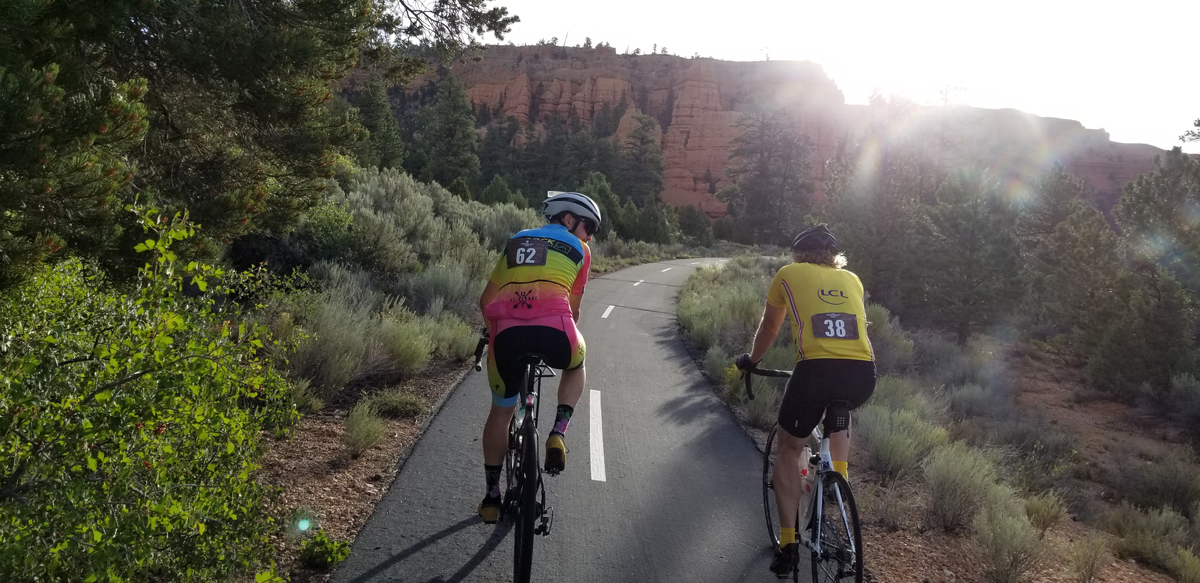By Lukas Brinkerhoff – I’ve just finished the hardest 50 miles of my life. I’m sitting under a big red tent proudly sporting my Red Rock kit and feeling completely blown. It’s been a while since I’ve felt this way. My right thigh has been threatening to cramp since mile 30. I see some pickles. I pop one in my mouth trying to use the least effort possible.

As per Mooseknuckler Cycling Alliance Standard Operating Procedures, there is a beer waiting for me. I know it’s ice cold and only about 10 feet away. I don’t want it. Instead, I keep sipping down water trying to move past this feeling of being done.
What I’ve just completed was pitched to me as being easy. By the metrics, it was probably one of the easier 50-mile rides I’ve done. It was all on pavement. My bike was not loaded down with anything but water and some snacks. There was some climbing, but it was minimal and mellow. The scenery was fantastic, we went at a fairly slow pace, and yet, I was blown.
I guess with the proper preparation it’s possible to make any ride difficult.

Step 1: Don’t ride your bike.
For all intents and purposes, I stopped riding my bike about three months prior. This wasn’t a conscience decision, it just kind of happened that way. And before you start burning this article, when I say I stopped riding my bike I mean for any real distance. Almost all the riding I did in the last three months was in three block increments, three blocks to work and then three blocks home. Occasionally, the need for food arose, and I would ride the two blocks to the grocery store. So, to say that I didn’t ride at all isn’t accurate, but at the same time, it kind of is.
I also may be glossing over one or two rides in between there, but 20 miles once doesn’t exactly maintain a level of fitness. And that’s the key, don’t do anything that would actually keep you in cycling shape.
Step 2: Beer is your friend.
And by friend, I mean your BFF. That one person you would spend all your time with if you possibly could and you still wouldn’t get sick of them. Some may say this is a problem. I say it’s ok to be passionate about things. This happens to be my thing. It also happens to be a big bonus in the “making things difficult” department. While I’ve read that beer is a great recovery drink, it apparently is not a great drink for maintaining endurance whilst not actually doing anything else to maintain that endurance. Unless, of course, you are trying to see how much beer you can drink.
Step 3: Forget everything you may have once known about nutrition
Keeping your body fueled during a ride can often make or break a ride. In this case, there is no reason to try and do it right, so go ahead and through everything you know or think you know about nutrition right out the window.
For breakfast, eat exactly half of what you think you should. Give the other half to your friend who is also riding and make sure they don’t eat it either. Then drink a bunch of coffee.
Typically, you would drink water at regular intervals. Stop doing that. Instead, drink a little bit here and then forget that you have water altogether and just ride. Any fuel that you may have forgotten about and then remembered 45 seconds before the ride began, should remain nicely stored. Only when you are pretty much bonking and trying to stay ahead of the group of ladies in fake Red Rock Bicycle kits because that would be too much to be passed by them, can you finally eat. And yes, you should then eat all of it at once as fast as you can.
Step 4: Suffer through it
At this point, it is important to point out that riding bicycles is often more about knowing how to suffer than it is about being good at riding bicycles. A smarter person would recognize their own failings and throw in the towel with a vow to learn from their mistakes, but that would be too easy. Depending on who you ask and what day of the week it is, I’m not very good at bikes, but I’ve learned to suffer with the best. I may not cross the line first, or second, or third, but I will cross that line and finish.
And finish I did.
As aforementioned, by the metrics the Desperado Duel is an easy 50-mile ride. There isn’t a ton of climbing and none of it is overly steep. The scenery is fantastic as the route takes you through Red Canyon which is Bryce Canyon’s little brother and shares the same fantastical hoodoos and red coloring of the iconic park. A good chunk of the ride is also on a separate bike path letting you pedal without having to worry about traffic and the parts that are on the highway have little traffic.
And the weather. For those of you not from the fiery pits of Southern Utah, July is a time when you do anything you can to escape the oppressive heat of the summer. Panguitch in July is a perfect way to do just that. The mornings are crisp and the evenings cool off nicely. It’s about the best riding weather you can find.
All that is fine and dandy, but isn’t riding all about the challenge? The Desperado Duel 50 certainly isn’t the hardest course you will encounter, but with the proper preparation you can turn it into a truly hard day that ends with you sitting under a tent, completely blown, eating pickles and wondering why it hurt so bad.
And that is what it’s all about.
Lukas Brinkerhoff blogs about mountain biking and life at mooseknuckleralliance.org.








